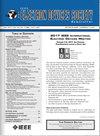二氧化硅环在TSV结构中的创新:三维芯片应用的热机械和信号完整性分析
IF 2.4
3区 工程技术
Q3 ENGINEERING, ELECTRICAL & ELECTRONIC
引用次数: 0
摘要
透硅通孔(TSV)作为三维(3D)芯片中至关重要的互连结构,具有显著提高器件性能和可靠性的作用。然而,随着互连密度和工作频率的增加,tsv的热机械可靠性和信号传输可靠性受到了严重威胁,导致3D芯片的整体可靠性下降。本文提出了一种具有二氧化硅环(SDR)结构的新型TSV,其抗漏电流性能和传输性能优于传统TSV及其衍生产品。在此基础上,建立了新型TSV的等效电路模型,并通过热力学分析、电磁分析和场路协同分析,深入研究了SDR的位置、高度和厚度对新型TSV热力学性能和信号完整性的影响。结果表明,SDR的位置、厚度和高度主要通过改变SDR所包围的面积和SDR本身的体积、横向导热系数和蓄热能力来影响TSV的热应力分布。在直流条件下,适当增加SDR与Cu柱之间的距离会增加插入损耗。SDR的内径、厚度和高度对TSV的完整性有不同的影响机制。研究结果为TSV优化和可靠性分析提供了有价值的指导。本文章由计算机程序翻译,如有差异,请以英文原文为准。
Silicon Dioxide Ring Innovations in TSV Structures: Analysis of Thermal-Mechanical and Signal Integrity for 3-D Chip Applications
Through-silicon via (TSV) as a crucial interconnection microstructure in three-dimensional (3D) chip, have significantly enhanced device performance and reliability. However, the increasing interconnect density and operating frequency now pose substantial threats to TSVs’ thermal-mechanical and signal transmission reliability, leading to a reduction in the overall reliability of 3D chip. In this study, a novel TSV with silicon dioxide ring (SDR) structure is proposed, its anti-current leakage performance and transmission performance are proved to be superior than traditional TSV and their derivative. On the basis, the equivalent circuit model of the proposed TSV is established, and the influence of the location, height and thickness of SDR on the thermal-mechanical performance and signal integrity of the new TSV is deeply investigated through thermomechanical analysis, electromagnetic analysis and field-circuit collaborative analysis. Results show that SDR’s position, thickness, and height mainly affect TSV’s thermal stress distribution by changing the area enclosed by the SDR and the volume of the SDR itself, transverse thermal conductivity, and the heat storage capacity. A moderate increase in the distance between SDR and the Cu column can enhance insertion loss in direct current (DC) condition. The inner diameter, thickness and height of SDR have different influence mechanisms on the integrity of TSV. These findings provide valuable guidance for TSV optimization and reliability analysis.
求助全文
通过发布文献求助,成功后即可免费获取论文全文。
去求助
来源期刊

IEEE Journal of the Electron Devices Society
Biochemistry, Genetics and Molecular Biology-Biotechnology
CiteScore
5.20
自引率
4.30%
发文量
124
审稿时长
9 weeks
期刊介绍:
The IEEE Journal of the Electron Devices Society (J-EDS) is an open-access, fully electronic scientific journal publishing papers ranging from fundamental to applied research that are scientifically rigorous and relevant to electron devices. The J-EDS publishes original and significant contributions relating to the theory, modelling, design, performance, and reliability of electron and ion integrated circuit devices and interconnects, involving insulators, metals, organic materials, micro-plasmas, semiconductors, quantum-effect structures, vacuum devices, and emerging materials with applications in bioelectronics, biomedical electronics, computation, communications, displays, microelectromechanics, imaging, micro-actuators, nanodevices, optoelectronics, photovoltaics, power IC''s, and micro-sensors. Tutorial and review papers on these subjects are, also, published. And, occasionally special issues with a collection of papers on particular areas in more depth and breadth are, also, published. J-EDS publishes all papers that are judged to be technically valid and original.
 求助内容:
求助内容: 应助结果提醒方式:
应助结果提醒方式:


